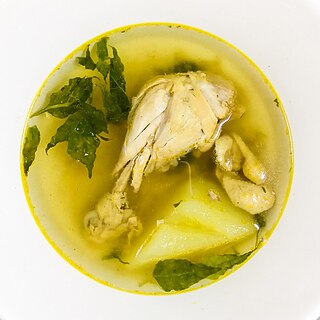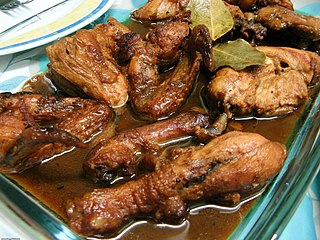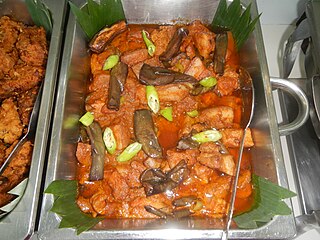Related Research Articles

Filipino cuisine is composed of the cuisines of more than a hundred distinct ethnolinguistic groups found throughout the Philippine archipelago. A majority of mainstream Filipino dishes that compose Filipino cuisine are from the food traditions of various ethnolinguistic groups and tribes of the archipelago, including the Ilocano, Pangasinan, Kapampangan, Tagalog, Bicolano, Visayan, Chavacano and Maranao ethnolinguistic groups. The style of food making and preparation, and the dishes associated with them, have evolved over many centuries from a largely indigenous base shared with maritime Southeast Asia with varied influences from Chinese, Spanish and American cuisines, in line with the major waves of influence that had enriched the cultures of the archipelago, as well as others adapted to indigenous ingredients and the local palate.

Tinola is a Filipino soup usually served as a main entrée with white rice. Traditionally, this dish is cooked with chicken or fish, wedges of papaya, and leaves of the siling labuyo chili pepper in broth flavored with ginger, onions and fish sauce.

Dinuguan is a Filipino savory stew usually of pork offal and/or meat simmered in a rich, spicy dark gravy of pig blood, garlic, chili, and vinegar.

Ginataan, alternatively spelled guinataan, is a Filipino term which refers to food cooked with gatâ. Literally translated, ginataan means "done with coconut milk". Due to the general nature of the term, it can refer to a number of different dishes, each called ginataan, but distinct from one another.

Philippine adobo is a popular Filipino dish and cooking process in Philippine cuisine that involves meat, seafood, or vegetables marinated in vinegar, soy sauce, garlic, bay leaves, and black peppercorns, which is browned in oil, and simmered in the marinade. It has occasionally been considered the unofficial national dish in the Philippines.

Inihaw, also known as sinugba or inasal, are various types of grilled or pit-roasted barbecue dishes from the Philippines. They are usually made from pork or chicken and are served on bamboo skewers or in small cubes with a soy sauce and vinegar-based dip. The term can also refer to any meat or seafood dish cooked and served in a similar way. Inihaw are commonly sold as street food and are eaten with white rice or rice cooked in coconut leaves (pusô). Inihaw is sometimes referred to as Filipino barbecue or (informally) Pinoy BBQ.

Chicken inasal, commonly known simply as inasal, is a variant of the Filipino chicken dish known as lechon manok. It is chicken marinated in a mixture of calamansi, pepper, coconut vinegar and annatto, then grilled over hot coals while basted with the marinade. It is served with rice, calamansi, soy sauce, chicken oil and vinegar. A common dish in the Visayas, it is a popular specialty in the city of Bacolod, where an entire street market is dedicated to local dishes, particularly inasal. A sign in the heart of the market reads "Manokan Country". Many restaurant chains are famous for serving inasal, like Bacolod Chicken Inasal and Mang Inasal, which originated in Iloilo City.

Tiyula itum is a Filipino braised beef or goat soup or stew dish originating from the Tausug people. The dish is characteristically black due to the unique use of charred coconut meat.
Linagpang or nilagpang is a Filipino cooking process that originates from the Western Visayas. It involves first char-grilling, roasting, or broiling chicken or fish and then adding them to a soup with tomatoes, onions, scallions, and ginger.
Coconut soup is a fruit soup prepared using coconut milk or coconut fruit as a main ingredient. Many varieties of coconut soups exist in the world, including ginataan, laksa, sayur lodeh, soto, and tom kha kai, and myriad ingredients are used. They can be served hot or cold. While most coconut soups are savoury dishes, some varieties—such as binignit and kolak—are sweet dessert soups.

Pininyahang manok, commonly anglicized as pineapple chicken, is a Philippine dish consisting of chicken braised in a milk or coconut milk-based sauce with pineapples, carrots, potatoes, and bell peppers. Some variants of the dish use a chicken stock base instead of milk. The dish originates from Southern Luzon which was once a regional center of pineapple fiber production in the Spanish Philippines.

Pastil, or pastel, is a Filipino packed rice dish made with steamed rice wrapped in banana leaves with dry shredded beef, chicken, or fish. It originates from the Maguindanao people and is a popular, cheap breakfast meal in Mindanao, especially among Muslim Filipinos. Pastil is also known as patil, patel, patir, or pater in Maranao; and paster in Iranun.

Lechon manok is a Filipino spit-roasted chicken dish made with chicken marinated in a mixture of garlic, bay leaf, onion, black pepper, soy sauce, and patis. The marinade may also be sweetened with muscovado or brown sugar. It is stuffed with tanglad (lemongrass) and roasted over charcoal. It is typically eaten dipped in a toyomansi or silimansi mixture of soy sauce, calamansi, and labuyo chilis. It is paired with white rice or puso and commonly served with atchara pickles as a side dish. It is a very popular dish in the Philippines and is readily available at roadside restaurants.
Piaparan, also known as pipaparan, piaran, or piarun, is a Filipino dish consisting of meat or seafood cooked in a coconut milk-based broth with grated coconut, garlic, onions, ginger, turmeric, young wild shallots (sakurab), labuyo chili, and various vegetables and spiced with palapa. It originates from the Maranao people of Lanao del Sur. Piaparan means "shredded coconut" in Maranao and is a type of ginataan.

Binagoongan is a Filipino cooking process consisting of vegetables or meat sautéed or braised in bagoong alamang, garlic, black peppercorns, and bay leaves. Some recipes also add pineapples, chilis, or coconut cream to balance the flavors. The dish is characteristically quite salty with a strong umami flavor, which is why it is always paired with white rice and never eaten on its own. It is very similar to pinatisan which is cooked with patis, one of the by-products of fermenting bagoong.

Ginataang manok is a Filipino chicken soup made from chicken in coconut milk with green papaya and other vegetables, garlic, ginger, onion, patis or bagoong alamang, and salt and pepper. It is a type of ginataan. A common variant of the dish adds curry powder or non-native Indian spices and is known as Filipino chicken curry.
Binakol, also spelled binakoe, is a Filipino chicken soup made from chicken cooked in coconut water with grated coconut, green papaya, leafy vegetables, garlic, onion, ginger, lemongrass, and patis. It can also be spiced with chilis. Binakol can also be cooked with other kinds of meat or seafood. It was traditionally cooked inside bamboo tubes or directly on halved coconut shells. The dish originates from the Western Visayas, particularly the province of Aklan.
Inubaran is a Filipino chicken stew or soup made with chicken cooked with diced banana pith, coconut milk (gata) or coconut cream, a souring agent, lemongrass, and various spices. The souring agent is traditionally either batuan fruits or libas leaves. The name means "[cooked] with ubad ", not to be confused with ubod ; although ubod can sometimes be used as a substitute for ubad which can be difficult to acquire. It originates from the Western Visayas and is associated with the cuisines of the Aklanon people. Variants of the dish can also be made with other types of meat or seafood. It is a type of ginataan.
Junay or junai, is a Filipino packed rice dish wrapped in banana leaves with burnt coconut meat and various spices. It originates from the Tausug people of the Sulu Archipelago. It is made by boiling rice in coconut milk until half-cooked. It is then wrapped in banana leaves with pamapa, oil, salt, and siyunog lahing. It is further steamed in water until fully cooked. The spices and burnt coconut are also sold pre-mixed and are known as pipis itum.
Kulawo Filipino salad made with either minced banana blossoms or grilled eggplants cooked in coconut milk that is distinctively extracted from grated coconut meat toasted on live coals. It is a pre-colonial dish that originates from the provinces of Laguna and Quezon. Kulawo is a type of kilawin and ginataan. It is fully vegan and has a unique smoky taste that has been compared to smoked meat or fish dishes.
References
- ↑ "Pyanggang Tausug, Philippines". Savor Filipino Foods. Retrieved 5 March 2019.
- ↑ Thomas, Amanda. "Regional Cuisine of Mindanao". Balay.ph. Retrieved 5 March 2019.
- ↑ Alvarez, Lhas. "Chicken Pyanggang (Chicken in Blackened Coconut Curry) Recipe". Yummy.ph. Retrieved 5 March 2019.
